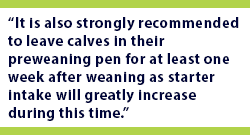
Calf Care Checklist: 5 Steps to Ensure a Smooth Transition at Weaning
 By Dr. Lucas Mitchell, Vita Plus calf and heifer specialist
By Dr. Lucas Mitchell, Vita Plus calf and heifer specialistThe transition period when a calf is weaned from milk or milk replacer is a stressful time in its life. However, if calves are adequately prepared for this transition and facilities are properly designed, stress can be minimized and calves can continue to grow during this period without missing a beat.
Step 1 – Keep calves healthy during the nursery phase.
Nursery calf health can be greatly affected by its first few hours of life. For calves to get off to their best start, ensure calves are born in a clean environment, dip navels with 7% tincture Iodine, and provide 1 gallon of high-quality colostrum to the calf within two hours.
To maximize nursery calf health, it is also important to provide adequate levels of nutrition from milk or milk replacer, good-quality fresh starter, clean water, clean and dry bedding, and adequate airflow.
A healthy nursery calf is going to eat more starter and better handle stress caused by weaning.
Step 2 – Make sure calves are consuming plenty of starter prior to weaning.
Starter intake is crucial for rumen development, and rumen development is crucial to properly digest dry feed. Proper digestion of dry feed ensures calves will thrive when weaned off milk or milk replacer.
 The general rule of thumb is calves should consume at least 2 pounds of starter per day for three consecutive days prior to weaning. It is also strongly recommended to leave calves in their preweaning pen for at least one week after weaning as starter intake will greatly increase during this time.
The general rule of thumb is calves should consume at least 2 pounds of starter per day for three consecutive days prior to weaning. It is also strongly recommended to leave calves in their preweaning pen for at least one week after weaning as starter intake will greatly increase during this time.
Step 3 – Socialize calves.
Calves raised in individual pens should be placed in small groups and given a chance to acclimate prior to being placed in larger groups. Weaning calves and immediately placing them in large groups may lead to additional stress, due to extra competition at the feedbunk, and result in poor performers that are more susceptible to health events. Pair-housing calves around the time of weaning can be an effective way to start to socialize calves without adding undue stress. Placing calves in groups of five to 10 approximately one week after weaning can also be an effective way to socialize calves while minimizing stress.
Step 4 – Transition to new feeds slowly.
Calves like consistency. However, feeds are likely to change after weaning. To minimize the amount of stress this may cause, it is important to handle feed transitions slowly. Many producers transition calves from a starter grain to a grower grain after weaning. To ensure a smooth transition, it is recommended that calves remain on the starter for one to two weeks after weaning. After this, the grower should be mixed with the starter for approximately one week before fully transitioning calves to the new grower grain.
It is also common to offer calves forage after weaning. However, to ensure calves don’t gorge on forage and continue eating starter or grower, slowly introduce calves to forage and do not allow them to have all they want right away.
Step 5 – Make sure calf transition pens are designed to meet their needs.
Calf transition pens should have adequate amounts of resting area, proper bunk space and bunk height. Continuing to provide calves with clean water and proper air ventilation during this time is also critical to a smooth transition.
Improper bunk dimensions, especially curbs that are too tall, are a common issue in transition pens that lead to calves pushing and struggling to reach feed. This may lead to reduced intake and growth, as well as increased health incidents. If calves are transitioned to pens with headlocks or slanted bars they need to reach through to eat, it may be beneficial to provide a small bunk within the pen that calves can eat from for one to two weeks while they learn how to eat using the new setup.
Signs that calves may be struggling with transition at weaning include increased health incidents and loss of body condition. Talk to your local youngstock specialist to review your calf rearing program and ensure your calves are transitioning smoothly.
Ensuring a smooth transition at weaning starts with how a calf is managed in its first few hours of life and ends with how the transition pens are designed. Making several key decisions and management steps along the way will help ensure calves handle weaning with minimal amounts of stress and continue growing on pace.
| Category: |
Animal health Calf and heifer nutrition Starting Strong - Calf Care |

